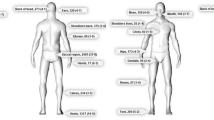Abstract
Introduction
The aim of this study was to compare the epidemiology of traumatic injuries and mortality outcomes between two tertiary-care trauma centers in Colombia using data from Pan-American Trauma Registry (PATR).
Methods
January 1–December 31, 2012, data from the Hospital Universitario del Valle (HUV, public) and Fundacion Valle del Lili (FVL, private) in Cali, Colombia, were considered. Differences in demographic and clinical information were compared using descriptive statistics. Propensity score matching was used to match patients on age, gender, and ISS. Within matched cohorts, multivariable logistic regression models were used to assess for differences in in-hospital mortality, further adjusting for insurance type, employment, heart rate, presence of hypotension (SBP < 90), and GCS score.
Results
HUV (8539; 78% male) and FVL (10,456; 60% male) had a combined total of 18,995 trauma cases in 2012 with comparable mean ages of 29.7 years. There were significant differences in insurance status, injury severity, and mechanism of injury between patients at HUV and FLV. On risk-adjusted logistic regression analyses with propensity score matched cohorts, the odds of death in HUV was higher compared to patients presenting at FVL hospital (OR [95% CI]:4.93 [3.37–7.21], p < 0.001).
Conclusion
The study established the utility of the PATR and revealed important trends in patient demographics, injury epidemiology, and mortality outcomes, which can be used to target trauma initiatives throughout the region. It underscores the profound importance that differences in case mix play in the risk of trauma-related mortality, further emphasizing the need to monitor and evaluate unique aspects of trauma in LMIC.
Level of evidence
III.
Similar content being viewed by others
References
World Health Organization (2010) Injuries and violence: the facts. World Health Organization, Geneva
Mathers CD, Loncar D (2006) Projections of global mortality and burden of disease from 2002 to 2030. PLoS Med. 3(11):2011–2030. doi:10.1371/journal.pmed.0030442
Aboutanos MB, Mora F, Rodas E et al (2010) Ratification of IATSIC/WHO’s guidelines for essential trauma care assessment in the South American region. World J Surg 34(11):2735–2744. doi:10.1007/s00268-010-0716-9
Fraade-Blanar L, Concha-Eastman A, Baker T (2007) Injury in the Americas: the relative burden and challenge. Pan Am J Public Heal 22(3):254–259. doi:10.1590/S1020-49892007000900005
Ordóñez CA, Pino LF, Tejada JW et al. (2012) Experience of two first level hospitals in the southwest region of Colombia on the implementation of the Panamerican Trauma Society International Trauma Registry. Rev Col Bras Cir 39(4):255–262. http://www.ncbi.nlm.nih.gov/pubmed/22936222
Hoffman K, Cole E, Playford ED, Grill E, Soberg HL, Brohi K (2014) Health outcome after major trauma: what are we measuring? PLoS ONE 9(7):e103082. doi:10.1371/journal.pone.0103082
Hofman K, Primack A, Keusch G, Hrynkow S (2005) Addressing the growing burden of trauma and injury in low- and middle-income countries. Am J Public Health 95(1):13–17. doi:10.2105/AJPH.2004.039354
Moore L, Clark DE (2008) The value of trauma registries. Injury 39(6):686–695. doi:10.1016/j.injury.2008.02.023
Jurkovich G, Mock C (1999) Systematic review of trauma system effectiveness based on registry comparisons. J Trauma Inj Infect Crit Care 47(3 Suppl):S46–S55
Haider AH, Hashmi ZG, Gupta S et al (2014) Benchmarking of trauma care worldwide: the potential value of an International Trauma Data Bank (ITDB). World J Surg 38(8):1882–1891. doi:10.1007/s00268-014-2629-5
Guerrero R, Gallego AL, Becerril-Montekio V, Vasques J (2011) Sistema de salud de Colombia. Salud Publica de Mexico 53(S2):144–155
Dozier KC, Miranda MA, Kwan RO, Cureton EL, Sadjadi J, Victorino GP (2010) Insurance coverage is associated with mortality after gunshot trauma. J Am Coll Surg 210:280
Haas JS, Goldman L (1994) Acutely injured patients with trauma in Massachusetts: differences in care and mortality by insurance status. Am J Public Health 84:1605
Falor A, Kim D, Bricker S et al (2014) Insurance status predicts survival for trauma patients undergoing urgent intervention. J Surg Res 188(1):238–242
Andreuccetti G et al (2012) A review of emergency room studies on alcohol and injuries conducted in Latin America and the Caribbean region. Drug Alcohol Rev 31:737–746
Rehm J, Taylor B, Room R (2006) Global burden of disease from alcohol, illicit drugs, and tobacco. Drug Alcohol Rev 25(6):503–513
Seow E, Wong HP, Phe A (2001) The pattern of ambulance arrivals in the emergency department of an acute care hospital in Singapore. Emerg Med J 18(4):297–299
Haddon W (1980) Advances in the epidemiology of injuries as a basis for public policy. Public Health Rep 95(5):411–421
Haider AH, Hashmi ZG, Zafar SN et al (2014) Developing best practices to study trauma outcomes in large databases: an evidence-based approach to determine the best mortality risk adjustment model. J Trauma Acute Care Surg 76(4):1061–1069
Arreola-Risa C, Mock C, Lojero-Wheatly L et al (2000) Low-cost improvements in prehospital trauma care in a Latin American City. J Trauma Inj Infect Crit Care 48(1):119–124
Haider AH, David J-S, Zafar SN et al (2013) Comparative effectiveness of in hospital trauma resuscitation at a French trauma center and matched patients treated in the United States. Ann Surg 258(1):178–183. doi:10.1097/SLA.0b013e31828226b6
Author information
Authors and Affiliations
Corresponding author
Ethics declarations
Conflict of interest
No disclosures relevant to this work.
Rights and permissions
About this article
Cite this article
Ramachandran, A., Ranjit, A., Zogg, C.K. et al. Comparison of Epidemiology of the Injuries and Outcomes in Two First-Level Trauma Centers in Colombia Using the Pan-American Trauma Registry System. World J Surg 41, 2224–2230 (2017). https://doi.org/10.1007/s00268-017-4013-8
Published:
Issue Date:
DOI: https://doi.org/10.1007/s00268-017-4013-8




